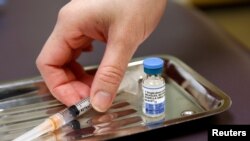US officials on Tuesday declared New York's worst measles epidemic in nearly 30 years officially over after months of emergency measures that included mandatory vaccinations.
About 654 people, many in areas with large Orthodox Jewish communities, were infected since October last year but there have been no new cases since mid-July, the city government said.
The official end of the outbreak, 42 days since the last reported case, comes before the start of the US financial capital's new school year Thursday.
Schools and nurseries were the focal points of government efforts to stop the spread of the disease.
"To keep our children and communities safe, I urge all New Yorkers to get vaccinated. It's the best defense we have," Mayor Bill de Blasio said in a statement.
Authorities declared measles eliminated in the United States in 2000 but there have been 1,234 cases of the potentially deadly disease reported in the country this year, the worst since 1992 according to the Center for Disease Control.
The rise comes as a growing anti-vaccine movement gains steam around the world, driven by fraudulent claims linking the MMR vaccine against measles, mumps and rubella, to a risk of autism in children.
New York city officials made vaccinations mandatory in the worst affected areas in April to help stem the epidemic. Schools were also allowed to turn away children who had not been vaccinated.
Those measures have been lifted, but a New York state law passed in June outlawing religious exemptions that had allowed parents to circumvent school-mandated vaccination remains in place.
"There may no longer be local transmission of measles in New York City, but the threat remains given other outbreaks in the US and around the world," said New York's health commissioner Oxiris Barbot.
The city government spent over $6 million and mobilized more than 500 employees to fight the outbreak.
Last month, the World Health Organization said there were 89,994 cases of measles in 48 European countries in the first six months of 2019.
That was more than double the number in the same period in 2018 when there were 44,175 cases, and already more than the 84,462 cases reported for all of 2018.











